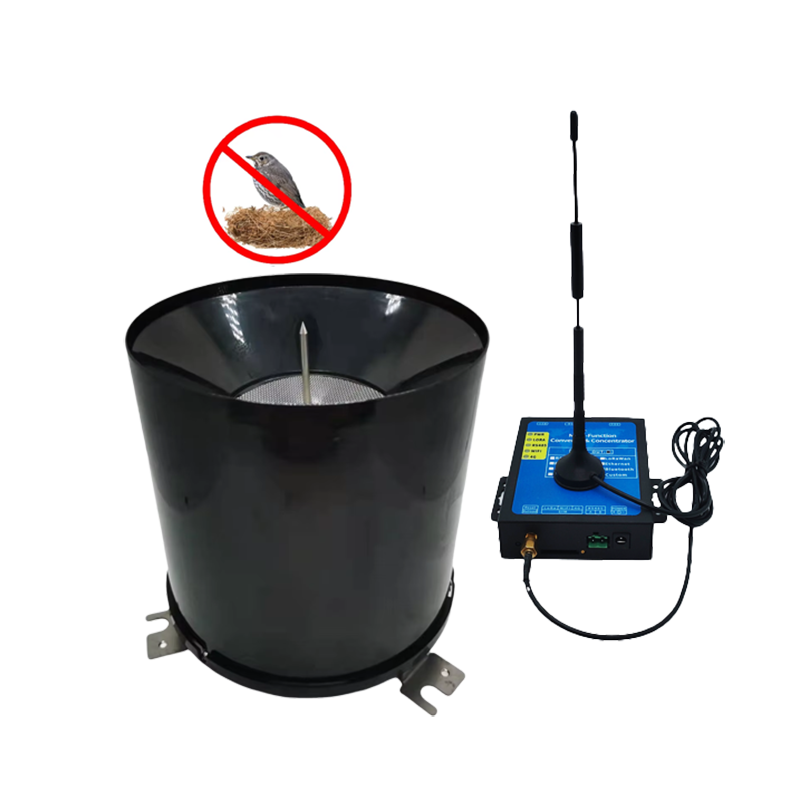परिचय
विविध भूगोल आणि समृद्ध कृषी वारशासाठी ओळखले जाणारे पेरू, पाणी व्यवस्थापन आणि हवामानातील परिवर्तनशीलतेशी संबंधित महत्त्वपूर्ण आव्हानांना तोंड देत आहे. ज्या देशात शेती हा अर्थव्यवस्थेचा एक महत्त्वाचा क्षेत्र आहे आणि लाखो लोकांसाठी उपजीविकेचे साधन आहे, तेथे अचूक हवामान डेटा आवश्यक आहे. या संदर्भात सर्वात मौल्यवान साधनांपैकी एक म्हणजेपर्जन्यमापक. हे साधे पण प्रभावी उपकरण पावसाबद्दल महत्त्वाची माहिती प्रदान करते, शेतकऱ्यांना माहितीपूर्ण निर्णय घेण्यास आणि त्यांच्या शेती पद्धतींना अनुकूलित करण्यास मदत करते.
पर्जन्यमापक समजून घेणे
पर्जन्यमापक हे एका विशिष्ट कालावधीत द्रवरूप पर्जन्याचे प्रमाण मोजण्यासाठी वापरले जाणारे एक उपकरण आहे. मॅन्युअल आणि ऑटोमेटेड आवृत्त्यांसह विविध प्रकारचे पर्जन्यमापक आहेत. ही उपकरणे एका श्रेणीबद्ध कंटेनरमध्ये पावसाचे पाणी गोळा करतात, ज्यामुळे पावसाची खोली अचूकपणे मोजता येते. शेतकऱ्यांसाठी, लागवड वेळापत्रक, सिंचन गरजा आणि पीक व्यवस्थापनाचे नियोजन करण्यासाठी ही माहिती महत्त्वाची आहे.
पाणी व्यवस्थापन वाढवणे
पेरूच्या अनेक प्रदेशांमध्ये, विशेषतः अँडीज आणि किनारी वाळवंटात, पाण्याची कमतरता ही एक मोठी आव्हान आहे. पर्जन्यमापक यंत्रे शेतकऱ्यांना पर्जन्यमानाचे निरीक्षण करण्यास मदत करतात, ज्यामुळे त्यांना जलस्रोतांचे अधिक प्रभावीपणे व्यवस्थापन करता येते. किती पाऊस पडला आहे हे जाणून घेतल्यास, शेतकरी त्यांच्या पिकांना सिंचनाची गरज आहे की अलिकडच्या पावसाने पुरेसा ओलावा दिला आहे हे ठरवू शकतात.
"रखरखीत प्रदेशातील शेतकऱ्यांसाठी, अचूक पर्जन्यमान डेटा महत्त्वाचा आहे," लिमा येथील कृषी अभियंता जुआन ऑर्टीझ म्हणतात. "पर्जन्यमापकामुळे ते त्यांच्या शेतात जास्त किंवा कमी सिंचन टाळू शकतात, जे दोन्ही पिकांच्या उत्पादनाला हानी पोहोचवू शकतात."
पीक नियोजन आणि व्यवस्थापनास पाठिंबा देणे
पावसाची वेळ आणि प्रमाण शेती पद्धतींवर लक्षणीय परिणाम करते. पर्जन्यमापकांच्या मदतीने, शेतकरी त्यांच्या लागवड आणि कापणीच्या वेळापत्रकाचे अधिक चांगले नियोजन करू शकतात. उदाहरणार्थ, पावसाळा कधी सुरू होतो हे समजून घेतल्यास शेतकरी अपेक्षित हवामान परिस्थितीला अनुकूल असलेली पिके लावू शकतात.
ज्या प्रदेशात निर्वाह शेती प्रचलित आहे, जसे की उंच प्रदेशात, पर्जन्यमापकांद्वारे वेळेवर दिले जाणारे ज्ञान यशस्वी कापणी आणि पीक अपयश यातील फरक दर्शवू शकते. शेतकरी पावसाच्या पद्धतींवर आधारित त्यांचे उपक्रम समायोजित करू शकतात, ज्यामुळे अप्रत्याशित हवामानाविरुद्ध त्यांची लवचिकता सुधारू शकते आणि त्यांची उत्पादकता जास्तीत जास्त वाढू शकते.
हवामानातील परिवर्तनशीलता कमी करणे
पेरूच्या हवामानावर एल निनो आणि ला निना सारख्या घटनांचा परिणाम होतो, ज्यामुळे अतिवृष्टी आणि दीर्घकाळ दुष्काळ यासारख्या अत्यंत हवामान घटना घडतात. बदलत्या परिस्थितीशी जुळवून घेण्यास शेतकऱ्यांना मदत करणारा रिअल-टाइम डेटा प्रदान करून अशा हवामान परिवर्तनशीलतेचे परिणाम कमी करण्यात पर्जन्यमापक महत्त्वाची भूमिका बजावतात.
उदाहरणार्थ, एल निनो वर्षात, ज्या भागात जास्त पाऊस पडू शकतो त्यांना पर्जन्यमापकांद्वारे वेळेवर गोळा केलेल्या माहितीचा फायदा होऊ शकतो. उलट, दुष्काळग्रस्त भागात, पाऊस कधी अपेक्षित आहे हे जाणून घेतल्यास शेतकऱ्यांना तयारी करण्यास मदत होऊ शकते - मग ते जलसंधारण तंत्रांद्वारे असो किंवा दुष्काळ-प्रतिरोधक पिके निवडून असो.
कृषी संशोधन आणि विकास वाढवणे
कृषी संशोधन आणि विकास प्रयत्नांसाठी पर्जन्यमापक देखील आवश्यक आहेत. कालांतराने पर्जन्यमानाच्या पद्धतींवरील डेटा गोळा करून, संशोधक ट्रेंडचे विश्लेषण करू शकतात आणि सुधारित कृषी पद्धतींसाठी शिफारसी करू शकतात. हा डेटा हवामान अनुकूलन धोरणे, सिंचन विकास आणि शाश्वत भू-वापर पद्धतींशी संबंधित धोरणांना माहिती देऊ शकतो.
"संशोधन संस्था शेतीच्या परिणामांचे मॉडेलिंग आणि अंदाज लावण्यासाठी अचूक आणि सातत्यपूर्ण पर्जन्यमान डेटावर अवलंबून असतात," असे पेरू विद्यापीठातील कृषी-हवामानशास्त्रज्ञ डॉ. मारिया गोंझालेझ स्पष्ट करतात. "हवामान बदलाच्या पार्श्वभूमीवर अन्न सुरक्षा वाढविण्यासाठी धोरणे विकसित करण्यासाठी पर्जन्यमापकांकडून गोळा केलेली माहिती अमूल्य आहे."
समुदाय सहभाग आणि प्रशिक्षण
पर्जन्यमापकांचे जास्तीत जास्त फायदे मिळवण्यासाठी, पेरू सरकार आणि विविध स्वयंसेवी संस्था सामुदायिक प्रशिक्षण कार्यक्रमांमध्ये वाढत्या प्रमाणात गुंतवणूक करत आहेत. हे उपक्रम शेतकऱ्यांना पर्जन्यमापकांचा प्रभावीपणे वापर कसा करायचा आणि त्यांनी पुरवलेल्या डेटाचा अर्थ कसा लावायचा याबद्दल शिक्षित करतात. स्थानिक शेतकऱ्यांना सक्षम करून, हे प्रयत्न चांगले जलसंपत्ती व्यवस्थापन आणि हवामानाच्या पद्धतींची अधिक चांगली समज निर्माण करण्यास प्रोत्साहन देतात.
"शेतकऱ्यांना पर्जन्यमापक वापरण्याचे आणि वाचण्याचे प्रशिक्षण दिल्याने अधिक माहितीपूर्ण कृषी समुदाय निर्माण होतो," असे ग्रामीण पेरूमधील शिक्षक पेड्रो रुईझ म्हणतात. "ते त्यांना अंदाज लावण्याऐवजी तथ्यात्मक, वास्तविक-वेळेच्या डेटावर आधारित निर्णय घेण्यास सक्षम करते."
निष्कर्ष
पेरूमधील शेतीवर पर्जन्यमापकांचा होणारा परिणाम अवास्तव आहे. पावसावरील महत्त्वपूर्ण डेटा प्रदान करून, ही उपकरणे पाणी व्यवस्थापन वाढवतात, पीक नियोजनाला पाठिंबा देतात आणि शेतकऱ्यांना हवामानातील परिवर्तनशीलतेशी जुळवून घेण्यास मदत करतात. देश हवामान बदल आणि पाण्याच्या कमतरतेमुळे निर्माण होणाऱ्या आव्हानांना तोंड देत असताना, शाश्वत कृषी पद्धतींना प्रोत्साहन देण्यासाठी आणि त्यांच्या उपजीविकेसाठी शेतीवर अवलंबून असलेल्या लाखो लोकांसाठी अन्न सुरक्षा सुनिश्चित करण्यासाठी पर्जन्यमापकांची भूमिका महत्त्वाची राहील. पेरूमध्ये एक लवचिक कृषी क्षेत्र निर्माण करण्यासाठी पायाभूत सुविधांमध्ये गुंतवणूक करणे आणि पर्जन्यमापकांच्या व्यापक वापरासाठी प्रशिक्षण देणे आवश्यक आहे.
पर्जन्यमापक सेन्सरच्या अधिक माहितीसाठी,
कृपया होंडे टेक्नॉलॉजी कंपनी लिमिटेडशी संपर्क साधा.
Email: info@hondetech.com
कंपनीची वेबसाइट: www.hondetechco.com
पोस्ट वेळ: फेब्रुवारी-१७-२०२५


